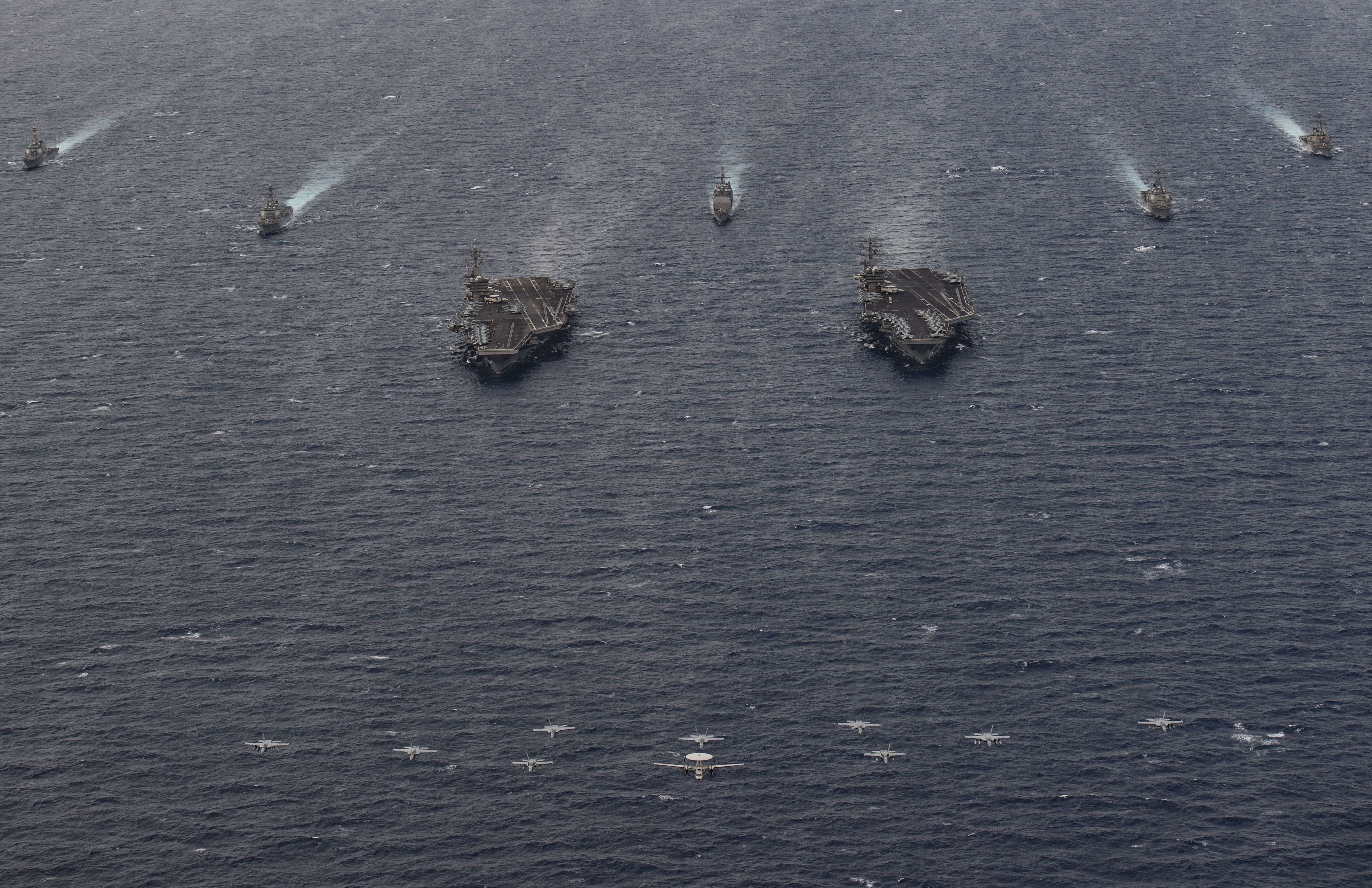The U.S. will have almost half of its aircraft carriers deployed in the Pacific in the coming weeks.
The South China Morning Post reported on February 14 that five of America’s 11 aircraft carriers would all likely soon be deployed there at the same time. Two of the carriers, the USS Carl Vinson and USS Theodore Roosevelt have been participating in a military exercise with Japan in the Philippine Sea, the USS Ronald Reagan is in port at Yokosuka, the USS Abraham Lincoln departed San Diego earlier this month, and the USS George Washington is expected to relieve the Reagan in a few weeks.
This is an unusual concentration of America’s naval power in one region at once, and it is being widely interpreted as a show of force meant for China and North Korea.
The Biden administration has made a point of making more shows of force in East Asia over the last year to reassure Asian allies that the U.S. has not forgotten about them. That isn’t surprising given the importance that the administration attaches to the “Indo-Pacific” and an active U.S. role in it, but in doing this it may also be contributing to increasing tensions with both Beijing and Pyongyang. We have already seen some of this in the back-and-forth between the U.S. and North Korea since last summer as North Korea has answered U.S. naval deployments to South Korea with additional missile tests and more bellicose rhetoric.
While these carrier deployments are presumably intended to signal American resolve and commitment to its regional allies, they could easily encourage China and North Korea to engage in their own reciprocal demonstrations of strength. They are also a reminder that the U.S. approach to East Asia is still very much a “military-first” approach that gives short shrift and devotes relatively few resources to economic statecraft and diplomacy. International relations scholar Van Jackson warned about the dangers of this approach more than two years ago, and since then the U.S. has only ramped up its military spending and deployments.
Because Washington’s attention has been focused so intently for the last four months on the war in Gaza and the other conflicts in the Middle East connected to it, it seems that the administration wants to show that it isn’t neglecting East Asia. The carrier deployments in the Pacific appear to be an attempt to “make up” for the continued massive over-investment of energy and resources in the Middle East.
The show of force may satisfy some allied governments, but it could also confirm the impression in both friendly and hostile capitals that the U.S. is overstretched and trying to take on too many tasks at the same time. The habit of reassuring allies so frequently has its own costs, including encouraging greater allied dependence, and when it is done too often it can have destabilizing effects on the wider region.
One of the principle weaknesses of U.S. foreign policy in East Asia is an overreliance on military deterrence. This tends to ratchet up tensions more than necessary and undermines credible assurances to adversaries. The U.S. excels at reassuring allies with its displays of military power, but because it often fails to strike a balance by giving adversaries assurances about its intentions, our government can feed the fears of Chinese and North Korean leaders and encourage them to assume the worst about what the U.S. is doing.
The carrier deployments suggest that the administration doesn’t understand the need for balancing deterrence and assurance. Failing to balance the two risks making conflict based on a miscalculation more likely. As the Quincy Institute’s Michael Swaine recently wrote about U.S. deterrence and Taiwan, “This balance is essential because, if the level of punishment or denial capability acquired is in fact seen as threatening the adversary’s most vital interests, the adversary, rather than being deterred from taking aggressive action, will become more inclined to undertake or threaten preemptive or punishing moves of its own in order to protect those interests, thus increasing, rather than decreasing, the chance of conflict.”
By relying so much on shows of force designed to intimidate China, the Biden administration increases the risk of a crisis.
The potential danger with North Korea is arguably even greater, since the North Korean government has a long history of responding to U.S. and allied pressure with its own provocations and threats. To the extent that Pyongyang perceives the deployment of so many carriers to the Pacific as directed even partly at North Korea, Kim Jong-un may conclude that he needs to show off his country’s own capabilities with additional missile tests and possibly even a new nuclear test.
Last year, North Korea reacted very angrily to the arrival of the USS Ronald Reagan in Busan, so it seems reasonable to expect an even harsher response if there are multiple carriers in the vicinity. Given the increasingly hostile rhetoric already coming from Pyongyang in the last few months, it would not take much for a new standoff between the U.S. and North Korea to begin.
The U.S. can ill afford a new crisis in East Asia on top of the other conflicts that it is involved in, but its overly militarized approach to the region is not the way to avoid it. If Washington wants to make conflicts in East Asia less likely, it will need to do a much better job of understanding its adversaries’ thinking and of offering them assurances that they can believe. Right now, the U.S. is doing far too little of both, and that is making the U.S. and its allies less secure than they could be.
- Why the US and China should agree on limits to their carrier fleets ›
- Are we at the brink of war in the Pacific? ›
- The US and China are dangerously close to a military confrontation in the South China Sea ›
















